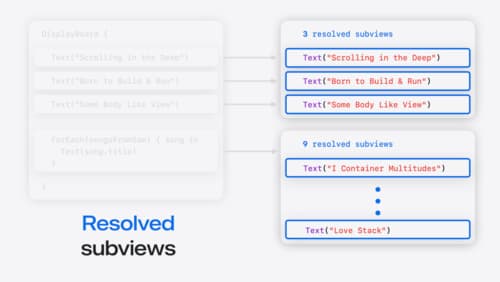how does swiftUI layout work?
Asked on 2024-09-07
1 search
SwiftUI layout works by using a declarative syntax to define the structure and appearance of user interfaces. Here are some key points about how SwiftUI layout functions:
-
Declarative Syntax: SwiftUI uses a declarative approach where you describe what the UI should look like, and SwiftUI takes care of rendering it. This is different from imperative UI frameworks where you have to specify how to achieve the desired UI.
-
Composition: SwiftUI heavily relies on composition. You can build complex UIs by composing smaller views. For example, you can use container views like
HStack,VStack, andZStackto arrange views horizontally, vertically, or in layers, respectively. This is discussed in the SwiftUI essentials session. -
Dynamic Layouts: SwiftUI can adapt layouts dynamically based on the environment, such as accessibility settings. For instance, you can use the
AnyLayouttype to switch between different layouts likeHStackandVStackbased on the text size or other conditions. This is covered in the Get started with Dynamic Type session. -
Container Views: SwiftUI provides container views that help in organizing the layout. These containers use a
ViewBuilderclosure to declare their children, making it easy to rearrange and experiment with different layouts. This is explained in the SwiftUI essentials session. -
Platform-Specific APIs: While SwiftUI provides a common set of components across platforms, it also offers specialized APIs for each platform to accommodate their unique design considerations. This is highlighted in the SwiftUI essentials session.
Overall, SwiftUI's layout system is designed to be flexible and adaptive, allowing developers to create responsive and accessible user interfaces with ease.

SwiftUI essentials
Join us on a tour of SwiftUI, Apple’s declarative user interface framework. Learn essential concepts for building apps in SwiftUI, like views, state variables, and layout. Discover the breadth of APIs for building fully featured experiences and crafting unique custom components. Whether you’re brand new to SwiftUI or an experienced developer, you’ll learn how to take advantage of what SwiftUI has to offer when building great apps.

Demystify SwiftUI containers
Learn about the capabilities of SwiftUI container views and build a mental model for how subviews are managed by their containers. Leverage new APIs to build your own custom containers, create modifiers to customize container content, and give your containers that extra polish that helps your apps stand out.

Migrate your TVML app to SwiftUI
SwiftUI helps you build great apps on all Apple platforms and is the preferred toolkit for bringing your content into the living room with tvOS 18. Learn how to use SwiftUI to create familiar layouts and controls from TVMLKit, and get tips and best practices.
